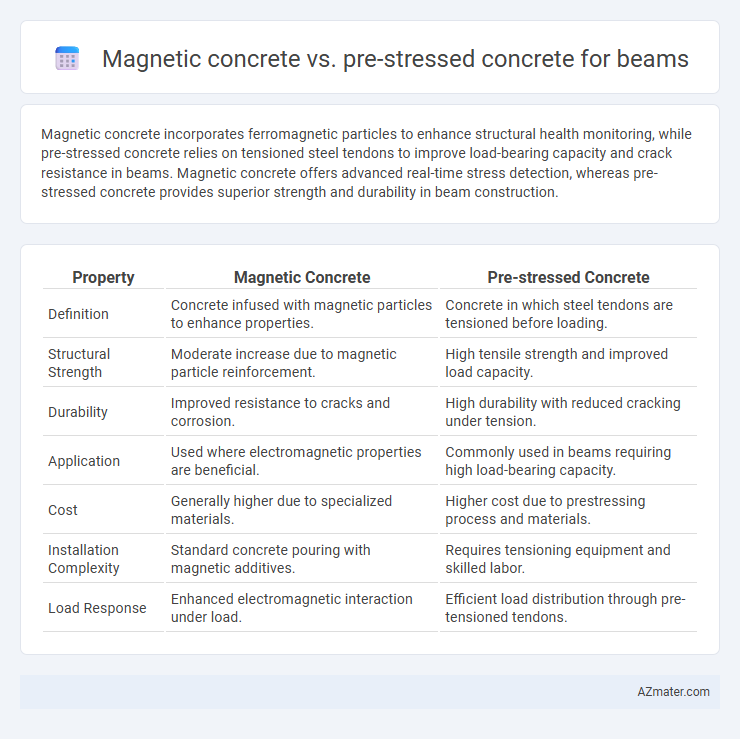Magnetic concrete incorporates ferromagnetic particles to enhance structural health monitoring, while pre-stressed concrete relies on tensioned steel tendons to improve load-bearing capacity and crack resistance in beams. Magnetic concrete offers advanced real-time stress detection, whereas pre-stressed concrete provides superior strength and durability in beam construction.
Table of Comparison
| Property | Magnetic Concrete | Pre-stressed Concrete |
|---|---|---|
| Definition | Concrete infused with magnetic particles to enhance properties. | Concrete in which steel tendons are tensioned before loading. |
| Structural Strength | Moderate increase due to magnetic particle reinforcement. | High tensile strength and improved load capacity. |
| Durability | Improved resistance to cracks and corrosion. | High durability with reduced cracking under tension. |
| Application | Used where electromagnetic properties are beneficial. | Commonly used in beams requiring high load-bearing capacity. |
| Cost | Generally higher due to specialized materials. | Higher cost due to prestressing process and materials. |
| Installation Complexity | Standard concrete pouring with magnetic additives. | Requires tensioning equipment and skilled labor. |
| Load Response | Enhanced electromagnetic interaction under load. | Efficient load distribution through pre-tensioned tendons. |
Introduction to Magnetic Concrete and Pre-stressed Concrete
Magnetic concrete incorporates ferromagnetic materials within its matrix, enabling it to interact with magnetic fields for enhanced structural monitoring and self-sensing capabilities. Pre-stressed concrete involves the application of internal stresses through tensioned steel tendons before loading, significantly improving tensile strength and reducing material deflections in beams. Both materials optimize beam performance, with magnetic concrete offering advanced functional benefits and pre-stressed concrete providing superior load-bearing capacity.
Material Composition and Properties
Magnetic concrete incorporates ferromagnetic materials like iron particles or magnetite into traditional concrete, enhancing electromagnetic properties and providing potential self-sensing and self-healing capabilities. Pre-stressed concrete beams utilize high-tensile steel tendons tensioned before or after casting to improve tensile strength and control cracking, relying on conventional cementitious material composition without magnetic additives. While magnetic concrete offers multifunctional benefits through material innovation, pre-stressed concrete excels in structural performance via mechanical stress application and optimized reinforcement placement.
Mechanisms of Strength Enhancement
Magnetic concrete enhances beam strength by integrating ferromagnetic materials that improve internal stress distribution and crack resistance through magnetic field-induced particle alignment. Pre-stressed concrete increases beam capacity by applying compressive stresses via tensioned steel tendons before loading, counteracting tensile stresses during service. These mechanisms result in superior load-bearing performance and durability for structural beams in various applications.
Design and Construction Techniques
Magnetic concrete incorporates ferromagnetic materials to enhance structural health monitoring through embedded sensors, enabling real-time stress and strain detection in beams. Pre-stressed concrete beams utilize tensioned steel tendons before or after casting to counteract tensile stresses, optimizing load-bearing capacity and reducing crack formation. Design considerations for magnetic concrete focus on sensor placement and electromagnetic compatibility, while pre-stressed concrete emphasizes precise tendon tensioning and anchorage systems to achieve desired stress profiles during construction.
Load-Bearing Performance Comparison
Magnetic concrete enhances load-bearing performance through improved crack resistance and self-healing properties enabled by embedded magnetic nanoparticles, resulting in increased structural durability under tensile and compressive stresses. Pre-stressed concrete beams utilize induced compressive stresses from tensioned steel tendons to counteract tensile forces, offering superior load capacity and reduced deflection compared to conventional concrete. Comparative studies show pre-stressed concrete outperforms magnetic concrete in maximum load capacity, while magnetic concrete provides advantages in durability and maintenance by mitigating micro-crack propagation.
Durability and Long-Term Performance
Magnetic concrete incorporates ferromagnetic materials that enhance crack detection and repair, significantly improving durability and long-term structural health monitoring compared to conventional pre-stressed concrete beams. Pre-stressed concrete beams, reinforced with tensioned steel tendons, exhibit superior load-bearing capacity and reduced crack widths but remain susceptible to corrosion and environmental degradation over time. The integration of magnetic properties in concrete provides a proactive approach to maintenance, extending lifespan and ensuring consistent performance in infrastructure applications.
Cost Analysis and Economic Feasibility
Magnetic concrete incorporates ferromagnetic materials, significantly increasing initial material costs compared to traditional pre-stressed concrete beams, which use high-strength steel tendons to achieve load-bearing efficiency and cost-effectiveness. The manufacturing and installation processes for pre-stressed concrete are well-established, resulting in lower labor and production expenses, whereas magnetic concrete requires specialized handling and additional equipment, impacting overall project budgets. Economic feasibility favors pre-stressed concrete for large-scale beam applications due to its optimized strength-to-cost ratio, while magnetic concrete's higher upfront investment limits its practicality to niche structural monitoring or specialized engineering scenarios.
Environmental Impact and Sustainability
Magnetic concrete incorporates iron particles that enable electromagnetic properties, reducing the need for extensive steel reinforcement and lowering carbon emissions compared to traditional pre-stressed concrete beams. Pre-stressed concrete, while strong and durable due to tensioned steel tendons, involves high energy consumption and CO2 emissions during steel production and concrete curing processes. Choosing magnetic concrete can enhance sustainability by minimizing raw material use and promoting recyclable components, contributing to a reduced environmental footprint in construction projects.
Applications in Modern Beam Construction
Magnetic concrete offers innovative applications in modern beam construction by enabling self-sensing capabilities and structural health monitoring, enhancing safety and maintenance efficiency. Pre-stressed concrete remains a dominant choice for beams due to its superior load-bearing capacity and resistance to tensile stresses, making it ideal for long-span bridges and high-rise buildings. The integration of magnetic concrete technology with traditional pre-stressed beams is emerging, promising smarter infrastructure with real-time data on stress distribution and potential damage.
Future Trends in Concrete Technology for Beams
Magnetic concrete incorporates ferromagnetic materials to enhance structural integrity and enable self-sensing capabilities, potentially revolutionizing beam monitoring and maintenance. Pre-stressed concrete remains crucial for beams due to its superior load-bearing capacity and crack resistance, with future trends focusing on improved fiber reinforcements and eco-friendly prestressing methods. Innovations in both materials aim to optimize durability, reduce carbon footprint, and integrate smart technologies for real-time structural health assessment in beam applications.

Infographic: Magnetic concrete vs Pre-stressed concrete for Beam
 azmater.com
azmater.com